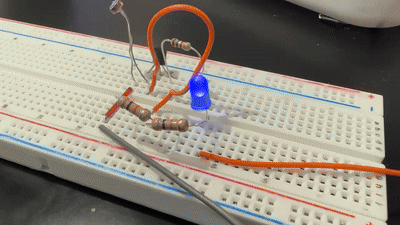 Perchance
Perchance
 Perchance
Perchance

This is my experience, and results of messing with electronic circuits, which features simple LED circuits, and experimental nightlights

This is a simple LED circuit, which when powered, it will turn on the LED. All it does is turn on the LED as it is a simple circuit.
I used the image as a reference to set up my simple circuit. This is the first simple circuit. A simple Resistor, LED, and 9V battery

With this setup, when voltage is applied, the Resistor decreases the voltage to prevent the LED from burning out from the 9V's, as LEDs weren't made for that voltage. The LED will glow.

This is the second simple LED circuit. The reference shows that the LEDs will be wired in series. So, more than 1 LED can glow at the same time.
I used the image as a reference again to set up my simple circuit. This is the second simple circuit. 2 Resistors, 2 LEDs, and 1 9V battery

With this setup, when voltage is applied, the Resistor decreases the voltage to prevent the LED from burning out from the 9V's; the voltage from the first LED will go to the second Resistor, which steps down again the voltage for the second LED, which works in series. Both of the LEDs will glow.

This is the reference for my nightlight. I can control the LED's brightness based on the environment's lighting.

With this setup, the photoresistor resists the voltage based on the light of the environment, which goes into a transistor that supplies the photoresistor's output resistance to the LED, resulting in an LED controlled by light.